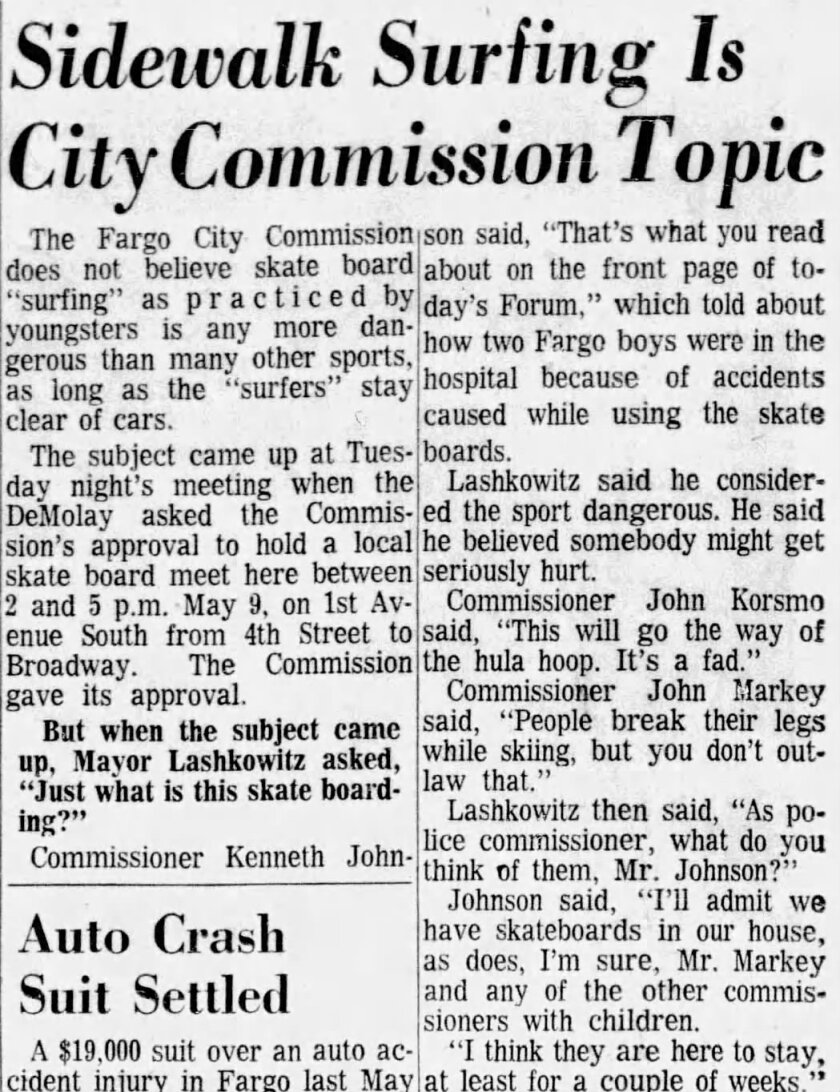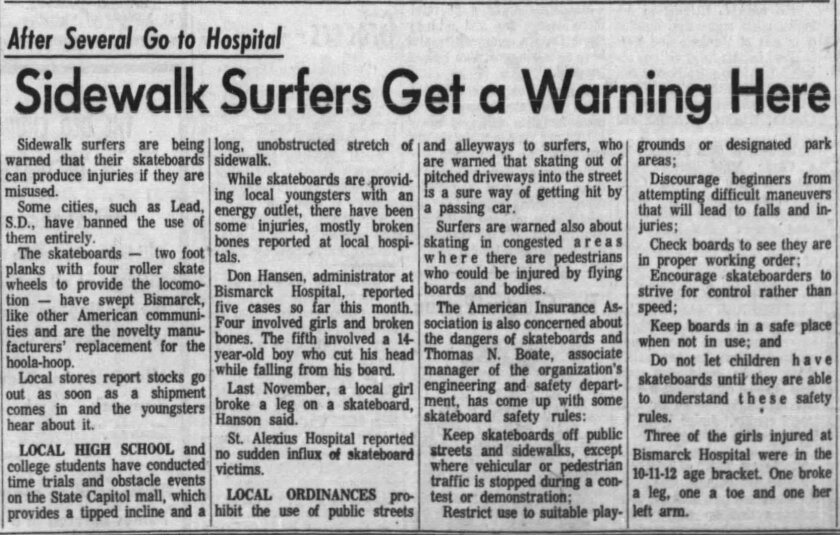As springtime weather approaches, let’s turn back the clock 60 years to a recreational sports explosion that hit our region.
The Sports Time Machine couldn’t help but notice a full-page photo spread in the April 22, 1965 edition of the Rochester Post-Bulletin while researching a previous story. Children of all ages were pictured with the newest neighborhood toy — the skateboard.
Believed to be a fad — and there’s some merit to that — skateboarding became a huge hit in 1965, and along with that, a rash of injuries followed.
Developed in the 1950s as California surfers craved a dryland fix, retail skateboard ads began to appear in the mid-’60s as teenager after teenager tried their luck standing on the moving board for several feet at a time.
Quickly, especially out west, it became competitive. In May 1965, the first International Skateboard Championship took place with three $500 college scholarships at stake. Sponsored by Skateboarder magazine, 300 youths participated.
About a week later, ABC televised the skateboarding championship as a segment on its “ABC’S Wide World of Sports,” growing the advancement of tricky moves on the wheeled boards.
It would take until 2021 before skateboarding became an Olympic sport, years after Tony Hawk became the most recognizable skateboarder in the world.
Some of us were just lucky to propel ourselves down the block. My older sister Debbie and I had a light blue skateboard with red wheels growing up in the ‘70s. A pebbled asphalt street provided a prickly vibration and fortunately, outside of a scrape or two, I don’t think either of us went fast enough to cause greater injury.
Goodbye hula hoop, hello skateboards
The hula hoop of the late 1950s and early ‘60s gave way to skateboards as the new residential craze.
ADVERTISEMENT
Back home, retailers, hospitals and even city councils were busy dealing with the new craze. In April 1965, Scheels locations in Fargo-Moorhead were selling the “Beginner’s Choice Super Surfer” for $1.99, a relative bargain over the $2.98 slip-on roller skates in the same advertisement.
In May, Home of Economy in Grand Forks had in stock the “Super-Surfer Deluxe Skate Board” made of laminated ash and mahogany with a lacquered finish for $7.98.
Kirk Gill remembers the day he was photographed riding with Bob Burfeind and Gunnar Erickson by Merle Dalen of the Rochester Post-Bulletin in 1965. Dalen and reporter Thomas Furth meshed their images and words in a near full-page spread in the Post-Bulletin.
"I was participating in a lot of other sports at the time and skateboarding was not a hobby for me like it is with young people today with the jumps and different things," Gill told the Sports Time Machine. "We were using it for entertainment and a little bit of transportation at the time."
Gill points out any safety equipment, such as a helmet, was not a consideration during that era. He said its been a long time since he's jumped on a board and rides more bike now than he did as a child.
"I have grandkids and they aren't skateboard crazy," he said. "We've had a few around the house but it's been a number of years for me, it'd go back all the way to the '60s."
Injuries pile up
Skateboarding and injuries went hand in hand as naivety or overconfidence soon drove elbows, wrists and knees to the pavement.
ADVERTISEMENT
Fargo city commissioners did not deem skateboarding any more dangerous than many other sports. When DeMolay asked to hold a skateboard meet in May 1965, Mayor Herschel Lashkowitz asked “Just what is this skate boarding?”

“That’s what you read about on the front page of today’s Forum,” commissioner Kenneth Johnson replied, noting a story about two boys’ injuries caused by skateboards.
In June 1965, the National Safety Council reported five deaths and 200 people had been injured skateboarding across the U.S. by skateboards in just a few months.
One Missouri father had had enough.
With his 12-year-old daughter in a cast as a result of a skateboarding accident, he threw the family’s six boards into a bonfire, proclaiming, “This ought to save some money.”

And newspapers were quick to report injuries, even involving older surfers.
The West Central Tribune in Willmar reported two Montevideo adults suffered two broken wrists with another fractured their leg. The Fargo Forum reported a 30-year-old woman fractured a hip and a 37-year-old female broke her wrist.
ADVERTISEMENT
“I’ll say we have,” said head nurse Margaret Shimmin of St. Luke’s emergency room in Fargo, when asked if there had been any skateboarding patients there in a May 2, 1965 story. Shimmin said there were about a dozen patients she has dealt with during her shifts.
“Some of the patients are rather sheepish when they tell you they were hurt skateboarding,” she told Forum reporter Gifford Herron.
Trampolines, water skiing and contact sports were surely causing their share of emergency room visits. Even the hula hoop, as Herron wrote, had its own risks as “oldsters threw their backs out of kilter from body gyrations they shouldn’t have tried at their age.”
Police in Minot, North Dakota, were busy with patrolling various hilly streets as daring skateboarders tried out speedy new moves in traffic. In Bismarck, thrill-seeking skateboarders found a stretch of inclined pavement on the State Capitol grounds a perfect spot to hold time trials and obstacle course events.
Dealing with it
Cities questioned their ordinances. Parents questioned their purchases. Kids questioned what other tricks can be performed.
Lead, South Dakota, put its foot down on skateboards, banning them entirely by April 1965.
Forum columnist Wayne Lubenow caught wind of a new policy at Moorhead's South Junior High School, where kids on crutches from skateboard accidents were released five minutes early from class to avoid being trampled in the hallways between classes.
ADVERTISEMENT
A seventh-grader vouched for the policy, saying six kids in her class alone had broken bones from skateboarding. All this by April 25, 1965, leading Lubenow to close his column:
“If you don’t have a broken leg from surfing, you aren’t anything, man.”














